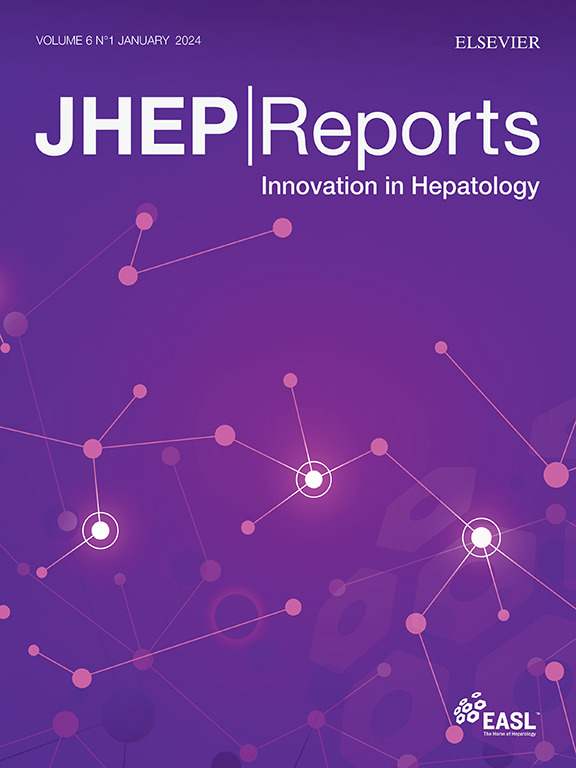鼠型戊型肝炎病毒(Rocahepevirus ratti)在中国人和大鼠中的流行
IF 9.5
1区 医学
Q1 GASTROENTEROLOGY & HEPATOLOGY
引用次数: 0
摘要
背景,目的:鼠戊型肝炎病毒;rHEV)是一种普遍存在的大鼠病原体,最近成为人类肝炎的一种病因。虽然在世界范围内发现了几例rHEV病例,但人类接触这种肝炎病原体的程度仍不明确。我们在中国进行了一项多中心监测研究,从一个健康的角度检查了人口统计学上不同人群的rHEV暴露。方法在这项多中心横断面研究中,我们对来自中国海南、香港和深圳三个中心的1199名肝炎患者(n = 655)和非肝炎患者(n = 544)进行了完全有效的rHEV IgG酶促免疫测定和反转录PCR。患者人群包括城市和农村人口。描述了受感染个体的特征及其与大鼠兽疫的系统发育联系。结果海南农村人群的rhev IgG血清阳性率(15/229,6.6%)高于深圳(9/427,2.1%)和香港(2/543,0.4%)(p <0.0001)。在多变量logistic回归中,校正优势比为20.52 (95% CI: 13.86-30.39),这种差异仍然存在。rHEV暴露也与年龄增加和环境啮齿动物暴露有关。我们在2例肝炎患者中观察到rHEV病毒血症(2/655;0.3%),海南和香港分别有乙型肝炎和肾移植。后者为慢性戊型肝炎,海南捕获的携带rHEV的大鼠19/509(3.7%)。这两株人rHEV分离株在系统发育上分别与海南和香港流行的鼠源rHEV毒株相关。结论人类间歇性暴露于rHEV,特别是在有啮齿动物暴露的农村环境中。显性肝炎发生在肝脏疾病或免疫抑制的个体中。溢出菌株与啮齿动物的动物流行病有关,为有针对性的除害提供了机会。影响和意义基于我们之前的研究发现,鼠罗卡hepevirus ratti (rHEV)是人类散发病毒性肝炎的一种新病因,我们研究了不同流行病学环境下人类暴露的rHEV。我们发现,生活在城市和农村环境中的个体间歇性暴露于戊型肝炎,后者的血清阳性率明显较高。有潜在肝脏疾病或免疫抑制的个体的外溢病毒感染与啮齿动物中流行的流行性rHEV毒株密切相关。医生和诊断实验室应将rHEV检测纳入病毒性肝炎的算法,而决策者应考虑对啮齿动物进行rHEV监测,以指导除害工作。本文章由计算机程序翻译,如有差异,请以英文原文为准。

Prevalence of Rocahepevirus ratti (rat hepatitis E virus) in humans and rats in China
Background & Aims
Rocahepevirus ratti (rat hepatitis E virus; rHEV) is a ubiquitous pathogen of rats that has recently emerged as a cause of hepatitis in humans. Although several rHEV cases have been detected worldwide, the extent of human exposure to this hepatitis agent is still poorly defined. We conducted a multicenter surveillance study in China examining rHEV exposures in demographically diverse human populations from a One Health perspective.
Methods
In this multicenter cross-sectional study, we used fully validated rHEV IgG enzymatic immunoassays and reverse transcription PCR in 1,199 individuals with (n = 655) or without hepatitis (n = 544) recruited from three centers in China (Hainan, Hong Kong, and Shenzhen). The patient population included both urban and rural populations. Characteristics of infected individuals and phylogenetic links with rat epizootics were described.
Results
rHEV IgG seroprevalence was higher in the rural Hainan cohort (15/229, 6.6%) compared with Shenzhen (9/427, 2.1%) and Hong Kong cohorts (2/543, 0.4%) (p <0.0001). This difference persisted on multivariable logistic regression with an adjusted odds ratio of 20.52 (95% CI: 13.86–30.39). rHEV exposure was also associated with increasing age and environmental rodent exposure. We observed rHEV viraemia in two hepatitis patients (2/655; 0.3%) in Hainan and Hong Kong with hepatitis B and renal transplantation, respectively. The latter developed chronic hepatitis E. 19/509 (3.7%) rats captured in Hainan harbored rHEV. Both human rHEV isolates were phylogenetically related to rodent-derived rHEV strains circulating in Hainan and Hong Kong, respectively.
Conclusions
Humans are intermittently exposed to rHEV, especially in rural settings with rodent exposure. Overt hepatitis occurs in individuals with liver disease or immunosuppression. Spillover strains are related to epizootics in rodents offering opportunities for targeted disinfestation.
Impact and implications
Building on our previous work finding that Rocahepevirus ratti (rHEV) is a novel cause of sporadic viral hepatitis in humans, we studied rHEV exposures in humans from various epidemiological settings. We found intermittent exposure to rat hepatitis E in individuals living in both urban and rural settings with a markedly higher seroprevalence in the latter. Spillover viremic infections in individuals with underlying liver disease or immunosuppression were closely linked to epizootic rHEV strains circulating in rodents. Physicians and diagnostic laboratories should incorporate rHEV testing in algorithms for viral hepatitis while policymakers should consider rHEV surveillance in rodents to guide disinfestation efforts.
求助全文
通过发布文献求助,成功后即可免费获取论文全文。
去求助
来源期刊

JHEP Reports
GASTROENTEROLOGY & HEPATOLOGY-
CiteScore
12.40
自引率
2.40%
发文量
161
审稿时长
36 days
期刊介绍:
JHEP Reports is an open access journal that is affiliated with the European Association for the Study of the Liver (EASL). It serves as a companion journal to the highly respected Journal of Hepatology.
The primary objective of JHEP Reports is to publish original papers and reviews that contribute to the advancement of knowledge in the field of liver diseases. The journal covers a wide range of topics, including basic, translational, and clinical research. It also focuses on global issues in hepatology, with particular emphasis on areas such as clinical trials, novel diagnostics, precision medicine and therapeutics, cancer research, cellular and molecular studies, artificial intelligence, microbiome research, epidemiology, and cutting-edge technologies.
In summary, JHEP Reports is dedicated to promoting scientific discoveries and innovations in liver diseases through the publication of high-quality research papers and reviews covering various aspects of hepatology.
 求助内容:
求助内容: 应助结果提醒方式:
应助结果提醒方式:


